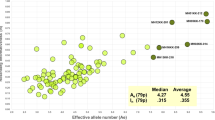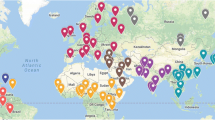Abstract
We have sequenced the entire mtDNA genome (mtGenome) of 241 individuals who match 1 of 18 common European Caucasian HV1/HV2 types, to identify sites that permit additional forensic discrimination. We found that over the entire mtGenome even individuals with the same HV1/HV2 type rarely match. Restricting attention to sites that are neutral with respect to phenotypic expression, we have selected eight panels of single nucleotide polymorphism (SNP) sites that are useful for additional discrimination. These panels were selected to be suitable for multiplex SNP typing assays, with 7–11 sites per panel. The panels are specific for one or more of the common HV1/HV2 types (or closely related types), permitting a directed approach that conserves limiting case specimen extracts while providing a maximal chance for additional discrimination. Discrimination provided by the panels reduces the frequency of the most common type in the European Caucasian population from ~7% to ~2%, and the 18 common types we analyzed are resolved to 105 different types, 55 of which are seen only once.

Similar content being viewed by others
References
Allard MW, Miller K, Wilson M, Monson K, Budowle B (2002) Characterization of the Caucasian haplogroups present in the SWGDAM forensic mtDNA dataset for 1771 human control region sequences. Scientific Working Group on DNA Analysis Methods. J Forensic Sci 47:1215–1223
Anderson S, Bankier AT, Barrell BG et al. (1981) Sequence and organization of the human mitochondrial genome. Nature 290:457–465
Andreasson H, Asp A, Alderborn A, Gyllensten U, Allen M (2002) Mitochondrial sequence analysis for forensic identification using pyrosequencing technology. Biotechniques 32:124–133
Andrews RM, Kubacka I, Chinnery PF, Lightowlers RN, Turnbull DM, Howell N (1999) Reanalysis and revision of the Cambridge reference sequence for human mitochondrial DNA. Nat Genet 23:147
Aquadro CF, Greenberg BD (1983) Human mitochondrial DNA variation and evolution: analysis of nucleotide sequences from seven individuals. Genetics 103:287–312
Armstrong B, Stewart M, Mazumder A (2000) Suspension arrays for high throughput, multiplexed single nucleotide polymorphism genotyping. Cytometry 40:102–108
Bandelt HJ, Quintana-Murci L, Salas A, Macaulay V (2002) The fingerprint of phantom mutations in mitochondrial DNA data. Am J Hum Genet 71:1150–1160
Bodenteich A, Mitchell LG, Polymeropoulos MH, Merril CR (1992) Dinucleotide repeat in the human mitochondrial D-loop. Hum Mol Genet 1:140
Brandstätter A, Parsons TJ, Niederstätter H, Parson W (2003) Rapid screening of mtDNA coding region SNPs for the identification of Caucasian haplogroups. Int J Legal Med 117:291–298
Brown MD, Shoffner JM, Kim YL et al. (1996) Mitochondrial DNA sequence analysis of four Alzheimer’s and Parkinson’s disease patients. Am J Med Genet 61:283–289
Cavelier L, Erikson I, Tammi M et al. (2002) MtDNA mutations in maternally inherited diabetes: presence of the 3397 ND1 mutation previously associated with Alzheimer’s and Parkinson’s disease. J Neuropathol Exp Neurol 61:634–639
Finnila S, Lehtonen MS, Majamaa K (2001) Phylogenetic network for European mtDNA. Am J Hum Genet 68:1475–1484
Gabriel MN, Calloway CD, Reynolds RL, Primorac D (2003) Identification of human remains by immobilized sequence-specific oligonucleotide probe analysis of mtDNA hypervariable regions I and II. Croatian Med J 44:293–298
Herrnstadt C, Elson JL, Fahy E et al. (2002) Reduced-median-network analysis of complete mitochondrial DNA coding region sequences for the major African, Asian, and European haplogroups. Am J Hum Genet 70:1152–1171
Herrnstadt C, Preston G, Howell N (2003) Errors, phantoms and otherwise, in human mtDNA sequences. Am J Hum Genet 72:1585–1586
Holland MM, Parsons TJ (1999) Mitochondrial DNA sequence analysis—Validation and use for forensic casework. Forensic Sci Rev 11:21–50
Horai S, Hayasaka K (1990) Intraspecific nucleotide sequence differences in the major noncoding region of human mitochondrial DNA. Am J Hum Genet 46:828–842
Ingman M, Gyllensten U (2003) Mitochondrial genome variation and evolutionary history of Australian and New Guinean Aborigines. Genome Res 13:1600–1606
Ingman M, Kaessmann H, Pääbo S, Gyllensten U (2000) Mitochondrial genome variation and the origin of modern humans. Nature 408:708–713
Kimura M (1983) The neutral theory of molecular evolution. Cambridge University Press, Cambridge
Lee MS, Levin BC (2002) MitoAnalyzer, a computer program and interactive web site to determine the effects of single nucleotide polymorphisms and mutations in human mitochondrial DNA. Mitochondrion 1:321–326
Lee SD, Lee YS, Lee JB (2002) Polymorphism in the mitochondrial cytochrome B gene in Koreans. An additional marker for individual identification. Int J Legal Med 116:74–78
Levin BC, Holland KA, Hancock DK et al. (2003) Comparison of the complete mtDNA genome sequences of human cell lines—HL-60 and GM10742A—from individuals with pro-myelocytic leukemia and leber heredity optic neuropathy, respectively, and the inclusion of HL-60 in the NIST human mitochondrial DNA standard reference material—SRM 2392-I. Mitochondrion 2:387–400
Lin MT, Simon DK, Ahn CH, Kim LM, Beal MF (2002) High aggregate burden of somatic mtDNA point mutations in aging and Alzheimer’s disease brain. Hum Mol Genet 11:133–145
Lutz S, Wittig H, Weisser HJ et al. (2000) Is it possible to differentiate mtDNA by means of HVIII in samples that cannot be distinguished by sequencing the HVI and HVII regions? Forensic Sci Int 113:97–101
Lutz-Bonengel S, Schmidt U, Schmitt T, Pollak S (2003) Sequence polymorphisms within the human mitochondrial genes MTATP6, MTATP8, and MTND4. Int J Legal Med 117:133–142
Maca-Meyer N, Gonzalez AM, Larruga JM, Flores C, Cabrera VM (2001) Major genomic mitochondrial lineages delineate early human expansions. BMC Genet 2:13
Macaulay V, Richards M, Hickey E et al. (1999) The emerging tree of west Eurasian mtDNAs: a synthesis of control-region sequences and RFLPs. Am J Hum Genet 64:232–249
Malyarchuk BA, Rogozin IB, Berikov VB, Derenko MV (2002) Analysis of phylogenetically reconstructed mutational spectra in human mitochondrial DNA control region. Hum Genet 111:46–53
Mehta AB, Vulliamy T, Gordon-Smith EC, Luzzatto L (1989) A new genetic polymorphism in the 16S ribosomal RNA gene of human mitochondrial DNA. Ann Hum Genet 53:303–310
Meyer S, Weiss G, Haeseler A von (1999) Pattern of nucleotide substitution and rate heterogeneity in the hypervariable regions I and II of human mtDNA. Genetics 152:1103–1110
Monson KL, Miller KWP, Wilson MR, DiZinno JA, Budowle B (2002) The mtDNA population database: an integrated software and database resource for forensic comparison. Forensic Sci Comm 4:2. http://www.fbi.gov/hq/lab/fsc/backissu/april2002/miller1.htm
Parsons TJ, Coble MD (2001) Increasing the forensic discrimination of mitochondrial DNA testing through analysis of the entire mitochondrial DNA genome. Croatian Med J 42:304–309
Saccone C, Pesole G, Sbisa E (1991) The main regulatory region of mammalian mitochondrial DNA: structure-function model and evolutionary pattern. J Mol Evol 33:83–91
Stewart JE, Fisher CL, Aagaard PJ et al. (2001) Length variation in HV2 of the human mitochondrial DNA control region. J Forensic Sci 46:862–870
Torroni A, Lott MT, Cabell MF, Chen YS, Lavergne L, Wallace DC (1994) mtDNA and the origin of Caucasians: identification of ancient Caucasian-specific haplogroups, one of which is prone to a recurrent somatic duplication in the D-loop region. Am J Hum Genet 55:760–776
Torroni A, Huoponen K, Francalacci P et al. (1996) Classification of European mtDNAs from an analysis of three European populations. Genetics 144:1835–1850
Tzen CY, Wu TY, Liu HF (2001) Sequence polymorphism in the coding region of mitochondrial genome encompassing position 8389–8865. Forensic Sci Int 120:204–209
Vallone PM, Just RS, Coble MD, Butler JM, Parsons TJ (2004) A multiplex allele-specific primer extension assay for forensically informative SNPs distributed throughout the mitochondrial genome. Int J Legal Med 118 (in press)
Wallace DC (1999) Mitochondrial diseases in man and mouse. Science 283:1482–1488
Wallace DC, Brown MD, Lott MT (1999) Mitochondrial DNA variation in human evolution and disease. Gene 238:211–230
Walsh PS, Metzger DA, Higuchi R (1991) Chelex 100 as a medium for simple extraction of DNA for PCR-based typing from forensic material. Biotechniques 10:506–513
Acknowledgements
We thank interns Rachel Barry, Trina Bersola, Serena Filosa, Victoria Glynn, Carrie Guyan, William Ivory, Devon Pierce, and Jessica Saunier for assistance with sequence analysis and data tabulation; James Ross, Richard Coughlin, and Aaron Waldner for computer support; Jon Norris, Vinh Lam, and others from Future Technologies, Inc. for database development; Suzanne Barritt, Demris Lee, Tim McMahon, and James Thomas (AFDIL) for discussion; Walther Parson, Harrald Niederstätter, and Anita Brandstätter (ILM, Innsbruck) for discussion; John Butler and Pete Vallone (NIST) for discussion; Connie Fisher (FBI) for providing samples; Eliana Andrea and Michael Parry (American Registry of Pathology) for grant administration assistance; Mitchell Holland for early conceptual and administrative support; and Kevin (Scott) Carroll, James C. Canik, and Brion C. Smith (AFDIL) for logistical, administrative, and moral support. This work was supported by a National Institute of Justice grant 2000–1J-CX-K010 to T.J.P. The opinions and assertions contained herein are solely those of the authors and are not to be construed as official or as views of the U.S. Department of Defense, the U.S. Department of the Army, or the U.S. Department of Justice.
Author information
Authors and Affiliations
Corresponding author
Rights and permissions
About this article
Cite this article
Coble, M.D., Just, R.S., O’Callaghan, J.E. et al. Single nucleotide polymorphisms over the entire mtDNA genome that increase the power of forensic testing in Caucasians. Int J Legal Med 118, 137–146 (2004). https://doi.org/10.1007/s00414-004-0427-6
Received:
Accepted:
Published:
Issue Date:
DOI: https://doi.org/10.1007/s00414-004-0427-6




